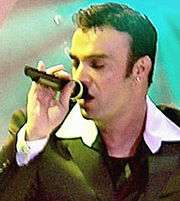Bat Yam
Bat Yam (Hebrew: בַּת יָם or בַּת־יָם ![]()
Bat Yam
| |
|---|---|
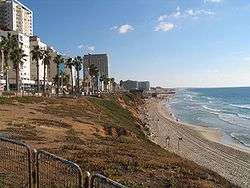 Bat Yam beach front | |
 Flag  | |
 Bat Yam 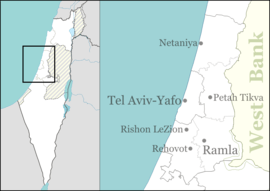 Bat Yam | |
| Coordinates: 32°01′N 34°45′E | |
| Country | |
| District | |
| Founded | 1926 |
| Government | |
| • Type | City (from 1958) |
| • Mayor | Tzvika Brot (acting) |
| Area | |
| • Total | 8,167 dunams (8.167 km2 or 3.153 sq mi) |
| Population (2018)[1] | |
| • Total | 128,774 |
| • Density | 16,000/km2 (41,000/sq mi) |
| Name meaning | lit. 'Daughter of the sea', can also mean 'mermaid' |
| Website | www.bat-yam.muni.il |
._Jaffa_%26_Tel-Aviv_from_the_south_LOC_matpc.17060.jpg)
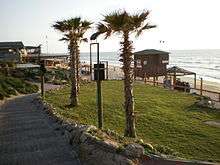
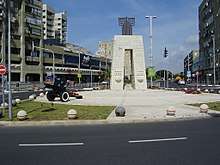
History
| Year | Pop. | ±% |
|---|---|---|
| 1948 | 2,300 | — |
| 1955 | 16,000 | +595.7% |
| 1961 | 31,700 | +98.1% |
| 1972 | 100,100 | +215.8% |
| 1983 | 128,700 | +28.6% |
| 1995 | 138,500 | +7.6% |
| 2008 | 130,300 | −5.9% |
| 2010 | 130,400 | +0.1% |
| 2011 | 128,200 | −1.7% |
| Source: CBS[2] | ||
Bat Yam was established in 1926 as Bayit VeGan (Hebrew: בית וגן; House and Garden). In 1930, it was resettled. In 1936, it was granted local council status. In 1937 it was renamed Bat Yam.[3] By 1945, 2,000 Jews were living in Bat Yam.[4] According to the Jewish National Fund, in 1947 it had a population of 4,000.[5]
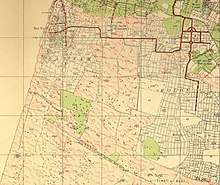

Following the United Nations vote in favour of a partition plan on November 29, 1947 and the subsequent civil war, inhabitants of both Bat Yam and Jaffa reported violent incidents, including sniping.[5][6] On May 13, 1948, Jaffa surrendered to Jewish forces.
In the years following Israel's creation, Bat Yam grew dramatically due to mass immigration and gained city status in 1958. A small Hasidic enclave of Bobover Hasidim, known as Kiryat Bobov, was established in 1959. The city later gained a sizeable community of Jews from Turkey. Bat Yam again experienced a period of rapid growth in the early 1980s to the late 1990s with the mass immigration of Jews from the former Soviet Union and Ethiopia.
There is also a small Arab community (0.4% as per 2012) in Bat Yam, both Muslim and Christian, many of whom relocated from Jaffa. The vast majority of Israelis of Vietnamese origin live in Bat Yam.[7]
Local government
In the early 2000s, after financial scandals under the leadership of Yehoshua Sagi, the city was on the brink of bankruptcy. In 2003 a new mayor, Shlomo Lahiani, was elected and the city began to rejuvenate. Large investments were made in education, culture and the appearance of the city. . In the 2008 municipal elections, Shlomo Lahiani was re-elected mayor of Bat Yam with 86% of the vote.[8] In 2014, Lahiani pleaded guilty to three counts of breach of public trust after being charged with bribery and income tax fraud.[9]
Politics and government
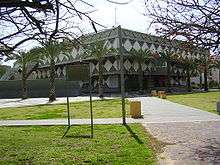
| Type | Name | Years |
|---|---|---|
| Head of council | Mintz Ben Zion | 1936–37 |
| Head of council | Yisrael Ben Zion | 1937–39 |
| Head of council | Yisrael Rabinovich-Teomim | 1939–43 |
| Head of council | Eliav Levai | 1943–50 |
| Head of council | David Ben Ari | 1950–58 |
| Mayor | David Ben Ari | 1958–63 |
| Mayor | Menachem Rothschild | 1963–73 |
| Mayor | Yitzhak Walker | 1973–77 |
| Mayor | David Mesika | 1977–78 |
| Mayor | Menachem Rothschild | 1978–83 |
| Mayor | Ehud Kinamon | 1983–93 |
| Mayor | Yehoshua Sagi | 1993–2003 |
| Mayor | Shlomo Lahiani | 2003–14 |
| Mayor | Yossi Bachar | 2014–18 |
| Mayor | Tzvika Brot | 2018–date |
| Source: Bat Yam's mayors on the official city website | ||
Art and culture
In 2008 the Bat-Yam International Biennale of Landscape Urbanism, which is devoted to re-examining urban spaces through art and architecture, was held in Bat Yam. In 2010 the second Biennale, "Timing" took place,[10] which featured site-specific installations from designers and architects from around the world.[11] The city has two shopping malls, Kanyon Bat Yam, which opened in 1993, and Kanyon Bat Yamon.
The location of Bat Yam on the Mediterranean makes it popular with beach-goers. Bat Yam has a 3.2 km (2 mi) long promenade along the ocean lined with pubs and restaurants. The city has six beaches, one of which is protected by a breakwater. The Museum of Bat Yam exhibits contemporary art.[12] Other museums include the Ben Ari Museum and Ryback Museum that houses the work of Issachar Ber Ryback. There is also a museum in the memory of the Yiddish writer Sholem Asch, who lived his last years in Bat Yam, and a small Holocaust museum.[13]
Transportation
Bat Yam-Yoseftal Railway Station and Bat Yam-Komemiyut Railway Station opened in 2011 as part of the new Tel Aviv – Rishon LeZion West line.[14] Bat Yam will also be the terminus for the red line of the Tel Aviv Light Rail.
Sports
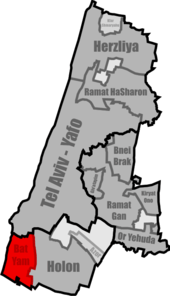
The city's major football club, Maccabi Ironi Bat Yam, currently plays in Liga Leumit, the third level of Israeli football. The club was formed by a 2004 merger of Hapoel Bat Yam (which had spent several seasons in the second division in the 1990s) and Maccabi Bat Yam.
Bat Yam's Al Gal beach is regarded to be one of the best surfing spots in the region, having fairly consistent surf conditions, especially during the summer months.
Twin towns – sister cities










Notable residents
- Shay Abutbul (1983–), soccer player
- Yohai Aharoni (1986–), soccer player
- Sholem Asch (1880–1957), Yiddish writer[16]
- Michael Barkai (1935–99), Commander of the Israeli Navy
- Miri Ben-Ari (1978–), hip hop violinist
- Moshe Biton, soccer player
- Vered "Vardush" Buskila (born 1983), Olympic sailor
- Tomer Chencinski (born 1984), Israeli–Canadian soccer player
- Eli Cohen (1924–1965), former Israeli spy[17]
- Meir Dagan (born 1945), Director of the Mossad[18][19]
- David D'Or (born 1965–), singer, composer, and songwriter.[20]
- Elana Eden (1940–), actress[21]
- Sharon Farber, composer
- Haim Gozali, mixed martial arts fighter
- Matt Haimovitz (1970–), US cellist
- Henryk Hechtkopf (1910–2004), illustrator
- Rita Katz (1963–), terrorism analyst
- Shlomo Lahiani (1965–), mayor of Bat Yam
- Achinoam Nini (1969–), singer
- Peter Roth (1974–), pop singer and composer
- Gal Shish (1989–), soccer player
- Itzik Zohar (1970–), soccer player
Gallery
 Raziel Street view
Raziel Street view
 "Kenyon Bat Yam" Mall
"Kenyon Bat Yam" Mall
References
- "Population in the Localities 2018" (XLS). Israel Central Bureau of Statistics. 25 August 2019. Retrieved 26 August 2019.
- "Statistical Abstract of Israel 2012 – No. 63 Subject 2 – Table No. 15". .cbs.gov.il. Archived from the original on 2013-10-20. Retrieved 2013-08-08.
- W. D. Battershill (1937). "Notice (23rd December 1937)". The Palestine Gazette. 745: 1287.
- Government of Palestine, Village Statistics, 1945, p52.
- Jewish National Fund (1949). Jewish Villages in Israel. Jerusalem: Hamadpis Liphshitz Press. p. 12.
- "Cleansing Jaffa: A detailed eye witness account, 202". Palestineremembered.com. Retrieved 2013-03-12.
- "In a Strange Land: Israel's Vietnamese Community – CULTURE". Worldandihomeschool.com. Archived from the original on 2004-01-25. Retrieved 2013-03-12.
- http://www.haaretz.co.il/news/education/1.1297119
- "Bat Yam mayor plea bargain a good deal for all". Haaretz. 2014-05-09. Retrieved 2014-09-19.
- "International Biennale of Landscape Urbanism". Metropolis Magazine. October 20, 2010. Archived from the original on October 24, 2010. Retrieved March 23, 2011.
- "Innovation by the Sea". Forward. October 19, 2010. Retrieved March 23, 2011.
- "of Bat Yam". Artreview.com. Retrieved March 23, 2011.
- MoBY: Museums of Bat Yam Archived December 20, 2015, at the Wayback Machine
- Bat Yam: New Israeli Riviera
- "מרטיןהיקל, ראשעירייתנויקלן – עירתאומהלבת-יםמברליןגרמניההגיעלביקורראשוןכדילקבועשיתופיפעולה". bat-yam.muni.il (in Hebrew). Bat Yam. 2020-02-17. Retrieved 2020-02-24.
- "MoBY: Museums of Art - Visit". moby.org.il. Retrieved 17 October 2017.
- Azoulay, Yuval (14 May 2010). "Unending agony for legendary spy Eli Cohen and his widow". Haaretz. Retrieved 30 August 2011.
- "מאיר דגן".
- "Real History and The Mossad's new chief".
- Agassi, Tirzah (March 25, 1994). "Going for Baroque Not!". The Jerusalem Post. Retrieved May 8, 2009.
- Parsons, Louella O. (27 March 1960). "Elana Eden: Hollywood's Newest Cinderella Story". The Milwaukee Sentinel. Retrieved 21 September 2013.
External links
| Wikivoyage has a travel guide for Bat Yam. |
| Wikimedia Commons has media related to Bat Yam. |
- Official website (in Hebrew)
- Surfing in Bat-Yam
